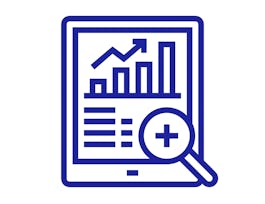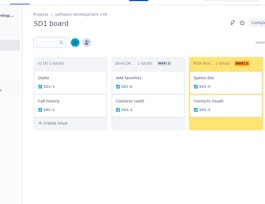This course will equip learners with a comprehensive understanding of Teradata Vantage's core concepts, architecture, and data management capabilities. Instruction focuses on foundational knowledge crucial for database administrators, IT managers, and data architects. Upon completion, learners will be able to: install and configure a Teradata database, load data appropriately, perform queries using SQL commands, and use data modeling to prepare data for more advanced query operations.

Une nouvelle année, de bonnes résolutions et des économies gigantesques : profitez d'un an d'accès illimité aux formations de Coursera Plus, pour $199. Économiser maintenant.


Getting Started with Teradata
Ce cours fait partie de Spécialisation Data Analytics with Teradata

Instructeur : Eric Grose
Inclus avec 
Expérience recommandée
Ce que vous apprendrez
Install, Configure, and use Teradata Studio
Data Management with Teradata
Data Modeling Basics with Teradata
Compétences que vous acquerrez
- Catégorie : Data Loading in Teradata
- Catégorie : Database Management Systems
- Catégorie : Teradata SQL
- Catégorie : Teradata Studio
Détails à connaître

Ajouter à votre profil LinkedIn
juillet 2024
25 devoirs
Découvrez comment les employés des entreprises prestigieuses maîtrisent des compétences recherchées

Élaborez votre expertise du sujet
- Apprenez de nouveaux concepts auprès d'experts du secteur
- Acquérez une compréhension de base d'un sujet ou d'un outil
- Développez des compétences professionnelles avec des projets pratiques
- Obtenez un certificat professionnel partageable


Obtenez un certificat professionnel
Ajoutez cette qualification à votre profil LinkedIn ou à votre CV
Partagez-le sur les réseaux sociaux et dans votre évaluation de performance

Il y a 5 modules dans ce cours
This module introduces Teradata's integral role in analytics architecture, emphasizing its ability to process and store diverse data, thereby converting it into valuable assets for organizations. Participants will learn how Teradata handles data from initial collection through to sophisticated processing and final analysis within Business Intelligence tools. The module delineates the distinct stages of data processing in Teradata, highlighting the journey from raw, unfiltered data to its refined, structured form. Key components of the Teradata Database Management System, such as Virtual Disks, the Parsing Engine, the Message Parsing Layer, and Access Module Processors, are explored, illustrating their specific functions in transforming data into actionable insights. Additionally, the module covers Teradata’s Massively Parallel Processing architecture, detailing how its design enables efficient, high-speed data processing and analysis. This comprehensive overview equips Data Analysts with the foundational knowledge needed to leverage Teradata’s robust analytics capabilities effectively.
Inclus
9 vidéos6 lectures6 devoirs1 sujet de discussion1 plugin
This module provides a comprehensive guide on installing, configuring, and effectively using Teradata Studio, focusing on equipping learners with the necessary skills to manage and interact with Teradata databases efficiently. Beginning with the installation process, the module offers step-by-step instructions tailored for both Windows and Mac users. Learners will explore the critical configurations needed to set up a Teradata Database, from creating administrative profiles to establishing the first database tables. You’ll distinguish the essentials of data management in Teradata, highlighting the different data types and SQL syntax to optimize data storage and retrieval. Practical demonstrations throughout the module reinforce the theoretical knowledge, and simulations allow you to click through the steps of the instructor demonstrations. By the end of this module, you will have the initial setup of Teradata Studio that lets you utilize its features for the rest of this specialization.
Inclus
12 vidéos5 lectures7 devoirs1 sujet de discussion3 plugins
In this module, you'll deepen your understanding of how to manage data effectively within the Teradata Vantage system. Starting with a practical look at the EXPLAIN plan, you will learn how this essential tool can help optimize your SQL queries by revealing the execution path and offering insights on how to enhance performance. Through instructor demonstrations and software simulations, you'll see how to apply the EXPLAIN command to actual data queries within Teradata Studio, giving you the skills to analyze and improve query efficiency in your future projects. This will be especially useful for queries that are complex or slow to process, helping you streamline operations and save valuable time. Furthermore, this module covers the critical roles and permissions within a Teradata environment. You'll explore the distinct responsibilities of Data Analysts, Database Administrators, and Developers, learning how each role contributes to secure and efficient database management. By understanding these roles, you'll be better equipped to manage data securely, ensuring that access is appropriately granted, and sensitive information is protected.
Inclus
5 vidéos3 lectures3 devoirs1 sujet de discussion
In Module 4, you will recognize the practical skills required to load data efficiently into Teradata, focusing on two primary techniques: bulk and batch data loading. As someone who may already have IT or database experience, you'll appreciate the nuances of how these methods improve performance and scalability in a Teradata environment. Starting with the distinction between bulk and batch data, you'll explore the conditions under which each method is preferable, learning to differentiate between scenarios that call for either bulk loading of large historical datasets or more frequent batch uploads. You'll be equipped with step-by-step guidance on using the Teradata Studio GUI to upload data, an essential skill for handling substantial volumes efficiently. Throughout the module, practical demonstrations and simulations will allow you to see these processes in action. By the end, you will not only recognize various data-loading use cases but also be proficient in executing them within Teradata Studio. This hands-on approach ensures you can apply what you learn directly to real-world data management tasks, effectively preparing you for roles that require advanced data handling capabilities.
Inclus
8 vidéos4 lectures3 devoirs1 sujet de discussion1 plugin
Module 5 is designed to equip you with a thorough understanding of data normalization and its importance in constructing efficient databases. This module is particularly valuable for those new to Teradata or transitioning from other IT disciplines, focusing on the practical applications of data modeling techniques. You will systematically explore the three forms of data normalization, detailed through explicit examples that demonstrate the transformation of data from unstructured to structured formats. Emphasis is placed on the third normal form, which is essential for reducing data redundancy and enhancing query performance. Additionally, the module distinguishes between logical and physical data models, essential knowledge for designing and implementing functional database systems. You will learn to integrate time-based columns into your data models, a critical step for creating relevant and timely analyses. Through direct instruction and practical exercises, you will develop the skills necessary for effective data management, preparing you to handle complex database tasks and improve system performance in any organizational context.
Inclus
14 vidéos3 lectures6 devoirs2 sujets de discussion
Instructeur

Offert par
Recommandé si vous êtes intéressé(e) par Data Analysis

LearnQuest

DeepLearning.AI

Coursera Project Network
Pour quelles raisons les étudiants sur Coursera nous choisissent-ils pour leur carrière ?





Ouvrez de nouvelles portes avec Coursera Plus
Accès illimité à 10,000+ cours de niveau international, projets pratiques et programmes de certification prêts à l'emploi - tous inclus dans votre abonnement.
Faites progresser votre carrière avec un diplôme en ligne
Obtenez un diplôme auprès d’universités de renommée mondiale - 100 % en ligne
Rejoignez plus de 3 400 entreprises mondiales qui ont choisi Coursera pour les affaires
Améliorez les compétences de vos employés pour exceller dans l’économie numérique
Foire Aux Questions
Access to lectures and assignments depends on your type of enrollment. If you take a course in audit mode, you will be able to see most course materials for free. To access graded assignments and to earn a Certificate, you will need to purchase the Certificate experience, during or after your audit. If you don't see the audit option:
The course may not offer an audit option. You can try a Free Trial instead, or apply for Financial Aid.
The course may offer 'Full Course, No Certificate' instead. This option lets you see all course materials, submit required assessments, and get a final grade. This also means that you will not be able to purchase a Certificate experience.
When you enroll in the course, you get access to all of the courses in the Specialization, and you earn a certificate when you complete the work. Your electronic Certificate will be added to your Accomplishments page - from there, you can print your Certificate or add it to your LinkedIn profile. If you only want to read and view the course content, you can audit the course for free.
If you subscribed, you get a 7-day free trial during which you can cancel at no penalty. After that, we don’t give refunds, but you can cancel your subscription at any time. See our full refund policy.


